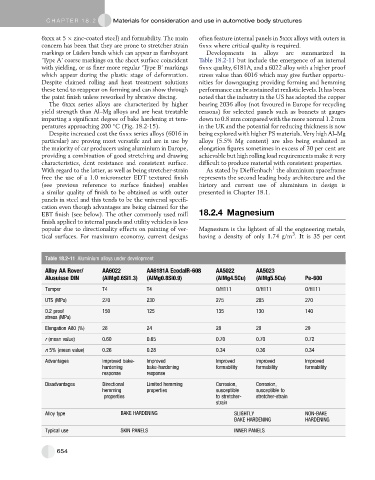Page 646 - Automotive Engineering Powertrain Chassis System and Vehicle Body
P. 646
CHAP TER 1 8. 2 Materials for consideration and use in automotive body structures
6xxx at 5 zinc-coated steel) and formability. The main often feature internal panels in 5xxx alloys with outers in
concern has been that they are prone to stretcher strain 6xxx where critical quality is required.
markings or Lu ¨ders bands which can appear as flamboyant Developments in alloys are summarized in
‘Type A’ coarse markings on the sheet surface coincident Table 18.2-11 but include the emergence of an internal
with yielding, or as finer more regular ‘Type B’ markings 6xxx quality, 6181A, and a 6022 alloy with a higher proof
which appear during the plastic stage of deformation. stress value than 6016 which may give further opportu-
Despite claimed rolling and heat treatment solutions nities for downgauging providing forming and hemming
these tend to reappear on forming and can show through performance can be sustainedat realisticlevels.It has been
the paint finish unless reworked by abrasive discing. noted that the industry in the US has adopted the copper
The 6xxx series alloys are characterized by higher bearing 2036 alloy (not favoured in Europe for recycling
yield strength than Al–Mg alloys and are heat treatable reasons) for selected panels such as bonnets at gauges
imparting a significant degree of bake hardening at tem- down to 0.8 mm compared with the more normal 1.2 mm
peratures approaching 200 C (Fig. 18.2-15). in the UK and the potential for reducing thickness is now
Despite increased cost the 6xxx series alloys (6016 in being explored with higher PS materials. Very high Al–Mg
particular) are proving most versatile and are in use by alloys (5.5% Mg content) are also being evaluated as
the majority of car producers using aluminium in Europe, elongation figures sometimes in excess of 30 per cent are
providing a combination of good stretching and drawing achievable but high rolling load requirements make it very
characteristics, dent resistance and consistent surface. difficult to produce material with consistent properties.
1
With regard to the latter, as well as being stretcher-strain As stated by Dieffenbach the aluminium spaceframe
free the use of a 1.0 micrometer EDT textured finish represents the second leading body architecture and the
(see previous reference to surface finishes) enables history and current use of aluminium in design is
a similar quality of finish to be obtained as with outer presented in Chapter 18.1.
panels in steel and this tends to be the universal specifi-
cation even though advantages are being claimed for the
EBT finish (see below). The other commonly used mill 18.2.4 Magnesium
finish applied to internal panels and utility vehicles is less
popular due to directionality effects on painting of ver- Magnesium is the lightest of all the engineering metals,
3
tical surfaces. For maximum economy, current designs having a density of only 1.74 g/m . It is 35 per cent
Table 18.2-11 Aluminium alloys under development
Alloy AA Rover/ AA6022 AA6181A EcodalR-608 AA5022 AA5023
Alusuisse DIN (AlMg0.6Si1.3) (AlMg0.8Si0.9) (AlMg4.5Cu) (AlMg5.5Cu) Pe-600
Temper T4 T4 O/H111 O/H111 O/H111
UTS (MPa) 270 230 275 285 270
0.2 proof 150 125 135 130 140
stress (MPa)
Elongation A80 (%) 26 24 28 29 29
r (mean value) 0.60 0.65 0.70 0.70 0.72
n 5% (mean value) 0.26 0.28 0.34 0.36 0.34
Advantages Improved bake- Improved Improved Improved Improved
hardening bake-hardening formability formability formability
response response
Disadvantages Directional Limited hemming Corrosion, Corrosion,
hemming properties susceptible susceptible to
properties to stretcher- stretcher-strain
strain
Alloy type BAKE HARDENING SLIGHTLY NON-BAKE
BAKE HARDENING HARDENING
Typical use SKIN PANELS INNER PANELS
654

